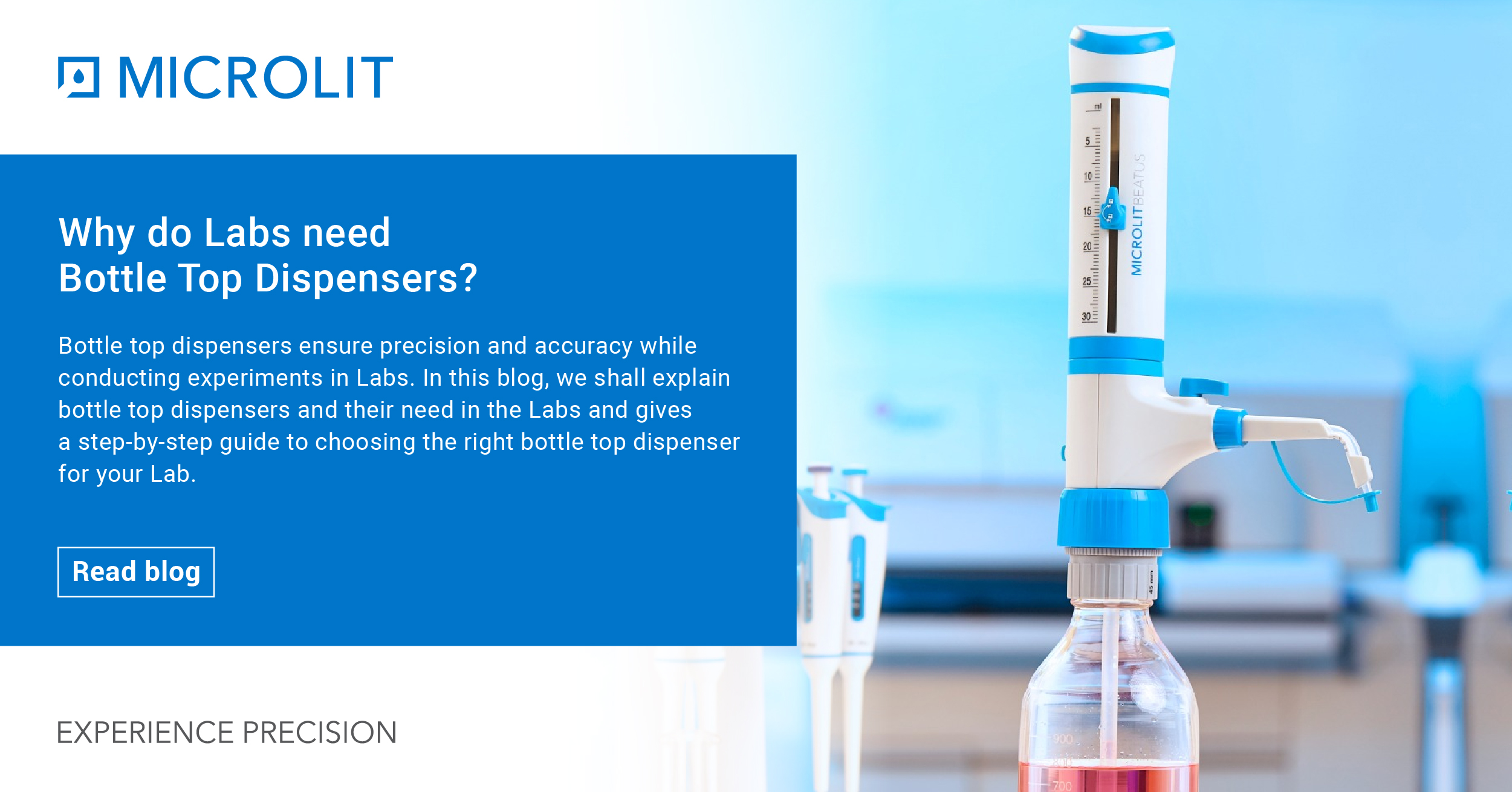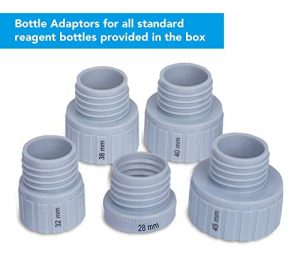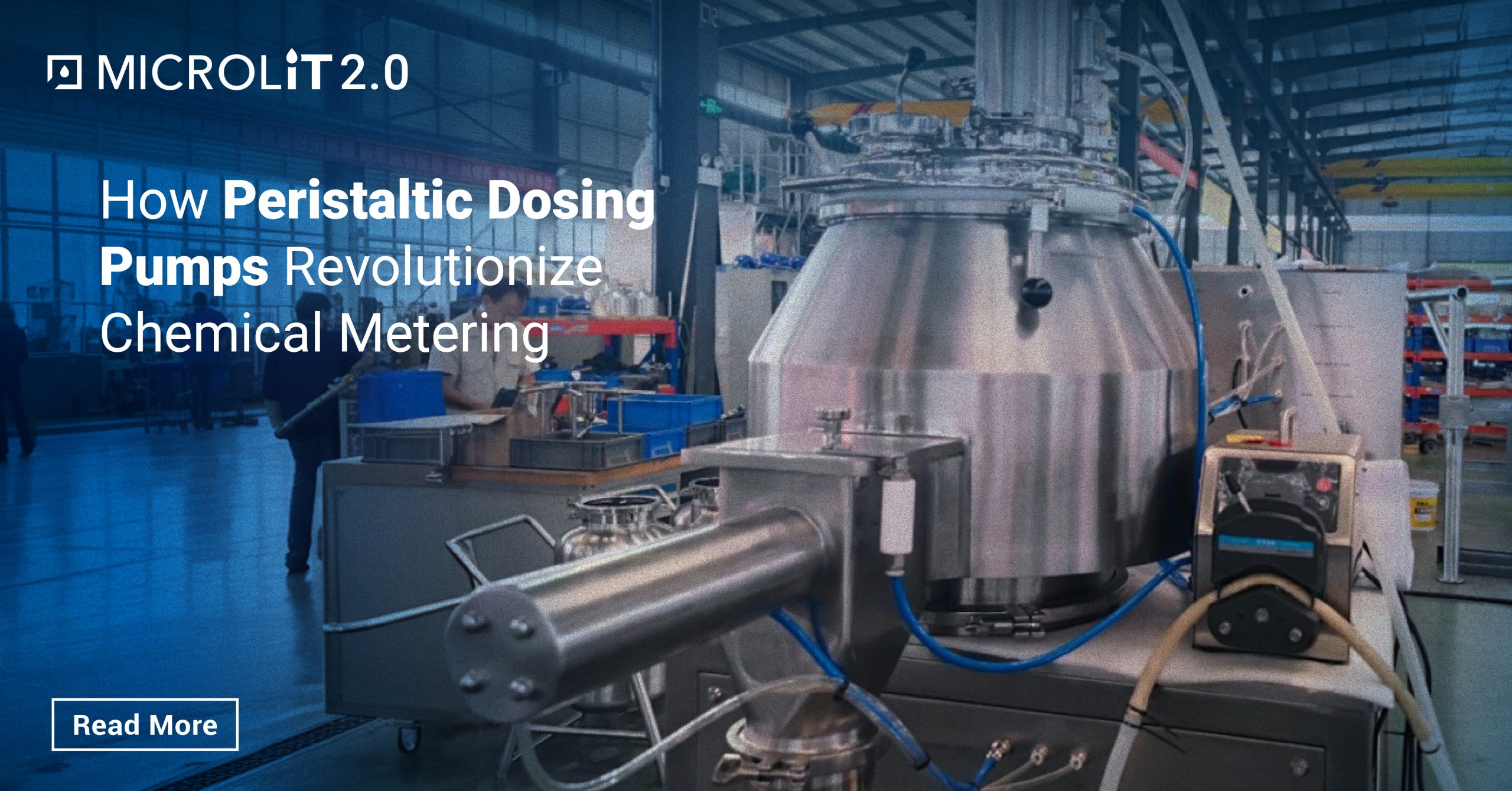Why do Labs need Bottle Top Dispensers?
- October 27, 2022
- ENQUIRE NOW

Laboratories contain many corrosive and robust chemicals that require proper handling for their usage. They must be dispensed, used, and disposed of appropriately to avoid untoward incidents. Bottle top dispensers ensure precision and accuracy in the labs. This blog explains bottle top dispensers and why they are needed in the labs and gives a step-by-step guide to choosing the right bottle top dispenser.
What is a Bottle Top Dispenser?
 A bottle top dispenser is a common lab instrument which is used to dispense precise amounts of chemicals/reagents, organic and inorganic solvents, oils etc. from bottles or other containers. The process of dispensing manually poses several risks such as spilling of chemicals, inaccurate measurements and even fatal lab accidents. In order to prevent such hazards and enhance lab safety, Bottle Top Dispensers are the go-to instruments for dispensing reagents safely and precisely in a laboratory environment.
A bottle top dispenser is a common lab instrument which is used to dispense precise amounts of chemicals/reagents, organic and inorganic solvents, oils etc. from bottles or other containers. The process of dispensing manually poses several risks such as spilling of chemicals, inaccurate measurements and even fatal lab accidents. In order to prevent such hazards and enhance lab safety, Bottle Top Dispensers are the go-to instruments for dispensing reagents safely and precisely in a laboratory environment.
Bottle top dispensers can safely dispense a fixed amount of liquid usually between 1ml and 100 ml, directly from a bottle to a receiving container. Bottle top dispensers help reduce the loss of reagents, saves time and increases work efficiency. Along with facilitating routine lab tasks, bottle top dispensers also improve productivity by speeding up the entire laboratory experimentation process.
The basic components of Bottle Top Dispensers are listed below:
- Bottle adaptors: The chemical bottles come in different neck sizes and therefore require adaptors to help mount the dispenser accurately on top of the bottle.

- Glass Barrel: It is used to hold the desired amount of reagent inside the instrument. When the piston is pulled upward, the liquid is plated into the glass barrel and when the piston is pushed down the liquid exits through the discharge tube.
- Volume adjustment knob: It is used to set the target volume which the user wants to be dispensed using the bottle top dispenser.
- Piston: It is a cylindrical structure that creates a vacuum inside the bottle to help dispense the chemical into the container.
- Dispensing nozzle: The dispensing nozzle is the passage for the chemical to flow into the container.
- Inlet tube: An inlet tube is a telescopic structure inside the reagent bottle to pull out the exact amount of liquid through the piston into the container.
- Nozzle cap: When not in use, a nozzle cap prevents the fluid from spilling out and prevents any unwanted drops at the workplace and avoids contact with hazardous chemicals.
Need for Bottle Top Dispensers
Many industries and workplaces like laboratories require a Bottle top dispenser to carry out work with ease and efficiency. Some of the important ones are discussed below:
- Pharmaceutical industries: Fuming acids, alkaline solutions like potassium hydroxide or calcium carbonate, etc., are used in Pharma industries in a continuous manufacturing cycle. A Bottle top dispenser facilitates this cycle with minimal accidents and spillage.
- Educational institutions: Students undergo intensive training and risk while conducting various experiments and comes in contact with harmful chemicals. A bottle top dispenser reduces this risk substantially.
- Healthcare industries and hospitals: Laboratories in hospitals use bottle-top dispensers for the safe handling of patient samples and experimental purposes.
- Biotechnology: Microbiological processes require sterile liquids and the use of multiple reagents, which is facilitated by bottle top dispenser.
- Monitoring of environmental conditions: A bottle to dispenser also extends its application in monitoring the surrounding environment in a lab or place where chemicals are stored and used.
Benefits of using a Bottle Top Dispenser
The Bottle top dispensers are not just routine equipment in a lab; they offer a wide variety of benefits listed below:
-
Safety
 Highly corrosive chemicals and reagents can be safely transferred to containers for various usages. The potential danger of contamination, spillage and harm from dangerous/harmful chemicals is minimised and reduced substantially. Some Bottle Top Dispensers like LENTUS® help to dispense highly corrosive acids such as Hydrofluoric Acid safely and accurately.
Highly corrosive chemicals and reagents can be safely transferred to containers for various usages. The potential danger of contamination, spillage and harm from dangerous/harmful chemicals is minimised and reduced substantially. Some Bottle Top Dispensers like LENTUS® help to dispense highly corrosive acids such as Hydrofluoric Acid safely and accurately.
-
Convenience
When a huge trial or experiment is conducted, certain chemicals will be used repeatedly. A bottle top dispenser makes things convenient by adjusting the required chemical volume under the right conditions.
-
Affordable
The bottle top dispensers are affordable and a worthy investment for a laboratory to dispense precise amounts of chemicals/reagents, organic and inorganic solvents, oils etc. from bottles or other containers with ease, safety and convenience.
-
Improved work efficiency
A bottle top dispenser makes work easier by reducing the hassles of handling potentially harmful chemicals. More experiments, industrial work, and lab work can be done simultaneously with improved safety and ease of use. Along with facilitating complex lab tasks, Bottle Top Dispensers also improve productivity by speeding up the experimentation process.
-
Minimises work hazards
Work hazards can occur when a huge amount of work occurs, and adequate precautions are not taken. A bottle top dispenser reduces work hazards by reducing the user’s contact with the chemical used and the spillage rate. Some dispensers come with the recirculation valve technology which helps in reducing the wastage of liquid during the purging process and avoid spillage of chemicals during storage.
-
Minimises waste generated
Spillage can waste a lot of chemicals, particularly when their availability is less. This reduces the waste generation rate in a laboratory, thus making it cost-effective for a workplace.
-
Accuracy
With the high precision technology, bottle top dispensers can easily transfer small quantities of liquids very accurately. The accuracy of the dispenser depends on the variety of bottle top dispenser which can be within ±0.5% – ±0.6% tolerance as per ISO 8655 dispensing standard.
Steps to choose the right Bottle Top Dispenser
How to choose the right bottle top dispenser?
The bottle top dispenser is a widely used scientific tool to dispense chemical reagent precisely. Generally choosing a bottle top dispenser depends on the amount of liquid and its types. However, there are other factors to consider when choosing a right bottle top dispenser for the laboratory.
-
Chemical Compatibility:
When selecting a bottle top dispenser, the user should check the chemical compatibility of the dispenser with the reagent to be dispensed. Some manufacturers offer different bottle top dispenser models for different types of reagents – organics, inorganics, solvents etc. However, Microlit dispenser, with its unique Springless Valve™ system is a universal dispenser for all types of reagents. All manufacturers offer a chemical compatibility chart with their dispensers. This includes all the commonly used reagents and their compatibility with the materials used in the construction of the dispenser. Please be sure to check this compatibility chart before making a purchase.
The commonly used reagents with bottle top dispensers can be categorized as follows:
Acids: Examples include Acetic Acid, Hydrochloric Acid, Sulfuric Acid, and Nitric acid
Bases: Examples include Acetyl chloride, Ammonia, Pyridine and sodium hydroxide
Organic Reagents: Examples include Toluene, Methanol, Trichloro trifluoroethane and Dichloromethane.
 Highly Corrosive Acids: Hydrofluoric Acid
Highly Corrosive Acids: Hydrofluoric Acid
Note that Microlit offers a special bottle top dispenser Microlit Lentus™ for use with highly corrosive acids and for use in trace analysis. The materials used in this dispenser ensure that it is not affected by direct contact with corrosive acids and does not allow the introduction of trace elements in the dispensed liquid.
-
Viscosity of the reagent:
If you need to dispense viscous liquids such as Essential Oils, Botanical Extracts, Grain Alcohol and Vegetable Glycerine, the applicable viscosity range for the dispenser needs to be considered:
Highly viscous liquids with a kinematic viscosity of between 75 to 500mm2/second will require careful selection while reagents having kinematic viscosity below 75 mm2/second can be used with any kind of bottle top dispenser efficiently.
-
Capacity of the dispenser:
Bottle top dispenser comes in both fixed volume and adjustable volume models with specific range of liquid quantity. The volume can be adjusted either manually with the help of a knob or dialled electronically through a control panel. So it is necessary to make sure that your selected bottle top dispensers are able to dispense the amount of liquid that is frequently required for your experiments. Note that dispensers with lower capacity offer higher accuracy and precision. So, if you want to dispense 10ml, a 1-10ml dispenser is recommended over a 2.5-30ml dispenser to ensure more accurate results.
The Microlit Bottle Top Dispensers – Ultimus, Beatus, Scitus & Lentus™ – are also available in variable volumes. To know more about Microlit’s Bottle Top Dispensers, please visit our website https://www.microlit.com/product-category/bottle-top-dispensers/ or email us at info@microlit.com





